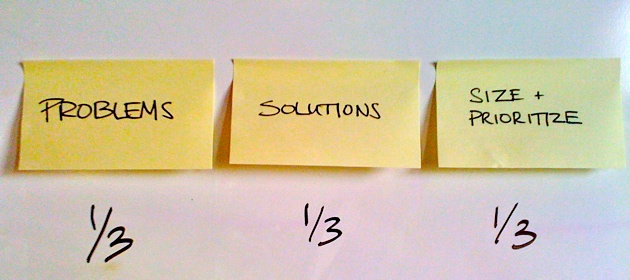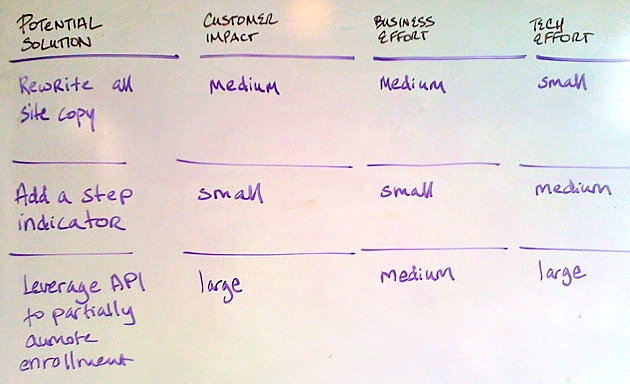The meeting-intensive culture within many organizations today makes it hard to achieve forward progress, especially on user experience enhancements. Often, meetings are filled with too many agenda items, lukewarm brainstorming, and tangential cross talk. If you are working in that kind of culture, a one-day workshop can be a great way to break out of the meeting rut.
In a typical corporate environment, the process of making improvements to an online or mobile experience might look like this:
The meeting-intensive culture within many organizations today makes it hard to achieve forward progress, especially on user experience enhancements. Often, meetings are filled with too many agenda items, lukewarm brainstorming, and tangential cross talk. If you are working in that kind of culture, a one-day workshop can be a great way to break out of the meeting rut.
In a typical corporate environment, the process of making improvements to an online or mobile experience might look like this:
- Someone schedules a meeting
- People talk in that meeting about a few problems and a few possible enhancements (not necessarily tied to the problems)
- Someone starts going off on a tangent about a problem that is not tied to the meeting topic
- Everyone leaves for another meeting
- Someone schedules follow-up meeting
- Some of those problems get rehashed, some new problems and ideas get introduced
And this continues ad infinitum, resulting in very few solutions and actions. But this whole dynamic can be changed for the better by instead throwing a one-day workshop. If you can limit the universe of what you are trying to improve to a reasonable focus, a group can identify problems, brainstorm solutions, and then prioritize those solutions in a single day.
Why a Workshop?
Workshops have several advantages over meetings by:
- Creating momentum
- Producing a sense of shared purpose
- Covering in one day what can take weeks or months of meetings to accomplish
- Allowing everyone to collaborate on a solution
How to Run a Workshop
Here is a basic formula for dividing up your one-day workshop into three equal sessions:
To explore this, let us look at a hypothetical problem that a health insurance company might have with its website. The company knows there are some issues with the online enrollment process, and they want to figure out how to make that process better in time for the next enrollment period.
Uncover Problems
Most organizations do a poor job of correctly identifying the problems that need to be solved. There is strong desire to skip ahead to the “fixing” stage, which results in vast amounts of effort being spent on short-term fixes or solving the wrong problems.
In the case of the health insurance site, the best way to have a productive “fix a few user experience issues” workshop is to begin the day with evidence of the real problem(s). Such evidence might be:
- Several call center agents share stories of the problems customers typically call about.
- Call logs, survey results or clickstream data are printed in large format and taped to the wall.
- Some people unfamiliar with the product (friends, family, people from distant departments, etc.) attempt to use the product and then talk about their experiences.
- Video of past usability sessions or copies of usability reports are available.
- Issues are discovered as workshop participants try to use the site as customers would (e.g., trying to enroll their own families.)
- Anecdotal evidence is shared by workshop participants (e.g., “I’ve heard people are complaining that the confirmation page is missing information about what to do next.”)
Participants’ pet peeves or ideas about how the product should be designed are not real evidence of customers’ actual experiences. Very little time should be spent on this type of input (“Why can’t it have more whitespace?” or “I hate green.”). Use a flipchart or sticky notes to let people capture these pet peeves and agree to address them at a later time.
Once you have a list of real problems, prioritize them in order of severity and choose the top one or two to focus on during the next part of the workshop. Severity should reflect the priorities and goals set previously.
Brainstorm Solutions
The brainstorming session is the easy part of a workshop; people almost universally love thinking about how to solve problems. Here are some tips to make this workshop even more productive:
- Prioritize one or two of the problems rather than trying to solve everything.
- Break into smaller (cross-disciplinary) teams and then report ideas back to the group.
- Encourage everyone to contribute; the more ideas, the better.
- Try to defer discussion of how much effort a change might require, allowing solutions that may seem too time-consuming or expensive to stay on the table as they may later lead to solutions that fit the available resources.
- Provide sketching materials and encourage people to visualize the solution.
If the brainstorming session started with the right evidence, the path from problem to solution can be surprisingly simple. The main pitfall to watch for when brainstorming is automatically accepting the first reasonable solution, the solution with the loudest advocate, or the solution proposed by the highest-ranking person in the room. These are often not the best responses. Breaking into smaller teams is one way to avoid this. A good moderator may have additional methods of ensuring all ideas are considered equally and thoroughly.
Size and Prioritize Solutions
Here is a basic matrix you can use to weigh the size (level of effort) for a particular solution against the priority (potential benefit) of that solution and, hopefully, select possible resolutions:
Start by listing your potential solutions down the left-hand side of the table.
This phase of a workshop can be difficult, and it often bogs down in a quagmire of “we don’t know enough yet.” To make sizing and prioritization productive, here are a few tips:
- Use t-shirt sizing to rank the impact and effort of the potential solutions (small, medium, large, etc.)
- Acknowledge the reality of current workloads at this point. If the technology team is slammed, acknowledge that the only solutions that can move forward are the ones with a small level of effort from the tech team.
Wrapping Up Your Workshop
The path from the identification of a problem to a list of prioritized solutions is not always straight. If you cannot arrive at a collective decision in one day, do not despair. This is common. If your allotted time is running out and it is clear that no resolution can be reached, just shift from “deciding” to assigning tasks and next steps. At the end of a workshop, there is often terrific excitement and momentum that can be leveraged to send people off to:
- Gather additional evidence (where is the exact drop-out point in the enrollment process?)
- Explore alternate solutions (“While we all loved one of the solutions proposed, it’s just too big for now. Let’s figure out a quick fix we can do before the enrollment period begins.”)
- Research size in more detail (the IT team researches which of two possible solutions requires less effort.)
Nuts and Bolts
Who Should Attend: The more cross-disciplinary the workshop can be, the better. For example, invite call center agents, product managers, marketing team members, designers, copywriters, and the engineering team to engage in the dialog of problem-solving.
Devices Off: State at the beginning of your workshop that participation and engagement will not work if people are texting, checking email, or working on other projects. If people cannot fully participate, they simply should not be at the workshop.
Timing: Allocate two hours for each of the three sessions (problems, solutions, and sizing). Make sure to schedule breaks; otherwise people will start wandering off in the middle of the workshop. Designate times when people can eat, check email, visit the restroom, and have a few down moments. Providing food and drinks can also reduce wandering.
Have a Moderator: Someone needs to make sure that the right materials are available, that each workshop session has direction and purpose, that time limits are adhered to, and that the information on whiteboards gets recorded. Almost anyone can be the moderator, but an experienced moderator will make sessions more effective by redirecting activities if something is not working, managing overbearing personalities, and ensuring that goals are being met. If you do not have an opportunity to bring in an outside moderator, declare yourself the moderator and push forward. For some additional input on moderating successful workshops, see: Discombobulation, Fire-Breathing Dragons and Wet Noodles: Creating Productive Workshops in Scary Situations.
First Time Nerves: If you are new to running workshops and are concerned about making yours successful, just focus on having a clearly articulated objective for the day (e.g., to agree on one implementable improvement to the enrollment process) and an agenda of activities that you stick to. You can solicit help from participants to decide whether you are getting to the objective. And you can use the agenda to keep things moving forward even when you are not entirely sure whether the session is working as planned.
Conclusion
A workshop can provide a welcome respite from the dawdling drudgery of the classic “meeting.” When implemented properly, workshops provide an opportunity to solve problems in a constructive way that everyone involved can get excited about. Workshops are proactive and even fun—two good reasons to consider canceling your next meeting and throwing a workshop in its place.
Drawing Hand image provided by Shutterstock






